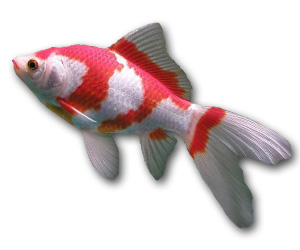Sarasa Comet

Quick Stats
| Size | Up to 12" (30cm) |
|---|---|
| Tank | Bigger is better. At least 20 litres per fish. |
| Swimming Area | All |
| Ph | 7.2 to 8.0 |
| Temperature | 74ºF to 76ºF (22 - 24°C) |
| Food | Flaked, live or frozen |
Common Name:
Sarasa Comet Goldfish
Distribution:
Goldfish are native to eastern Asia.
Colouration:
White with patches of red.
Lifespan:
20 years +. The oldest living Goldfish to on record was a goldfish named Tish, owned by Hilda and Gordon Hand of Thirsk, North. Yorkshire, England. Tish lived for 43 years after being won at a fairground in 1956.
Maintenance:
10 to 20% weekly. Most goldfish are undemanding in their care.
Feeding:
They are not fussy eaters and will accept all types of flake, frozen and live food.
Substrate:
Preferably gravel.
Tank Decor:
Decorating the tank is purely an individuals own preference. Gravel, decorative rocks, ornaments, and artificial plants as well as live plants are a few choices. Avoid sharp objects in the tank or you may end up with a cut or injured fish.
Filtration:
Goldfish produce a lot of waste so good filtration, with a good current is required.
Breeding:
Goldfish mature at about 1 year; however, they are in their prime about their 3rd year. A male that is ready to spawn will usually have tubercles about pin size that appear on the pectoral fins and gill covers. However, this does not always occur and has been seen in some females. Temperatures should be about 700F. during the day and 500F. at night. You will notice the spawning chase occur. The male will begin chasing the female for two to three hours, bumping into her abdomen. If she is ready eggs will spurt out and stick to the first thing they come in contact with. They are usually released in batches with the first batch being the best. The male fertilizes the eggs immediately by spraying milt over them. Good sized females can lay anywhere from 500-1000 eggs a spawn. You should remove the eggs immediately and rinse them in a bucket of aged water that is the same temperature as the tank they were removed from.
Your goldfish eggs should be kept in water that is not deeper than 6 inches. In deeper water the pressure can damage the fry and make it hard for them to reach the surface. After rinsing the eggs place them in a 20 gallon tank. You should raise the temperature to about 700F. The fish will hatch in 3-4 days. By the end of the first day you will notice that some eggs are clear tan to yellow while some are white. The ones that appear almost clear are the ones that are fertile. The others are more than likely infertile and will be subject to fungus. The fungused eggs should be removed immediately, or the fungus can spread to kill the other eggs.
The fish will hatch out along the region of his back, pulling his tail out first, then moving it to release its head. At birth the fish is about a 16th of an inch to an 8th of an inch long with two black eyes, a long notochord, and a full yolk sac. These translucent fry should not be disturbed. Do not be alarmed if they fall to the bottom. Within 48 hrs of hatching they will have absorbed their yolk sacs and an air bladder and rudimentary pectoral fin will become noticeable. After about 48 hours their air bladders will fill and they will start swimming normally and seeking food. They will eat anything they can fit into their mouths. This is when it becomes important to have some food on hand. Feeding the babies can be somewhat troublesome since they are so small. You must be sure to place enough food in the water that they can find it, but no too much to pollute the water. Keeping a continuous supply is needed. It is best to remove the uneaten food within a few hours and add more. Doing this helps maintain the water conditions. These little guys will grow rapidly and soon be requiring a lot of food. As the fish grow you will need to place them in larger tanks or divide them into tanks.
The following feeding schedule is one that I recommend
- After 48 hrs Crushed yolk of hard boiled egg and oatmeal paste, or there is a liquid available commercially
- After 2 weeks Baby brine shrimp and infusoria
- After 3 weeks Powdered foods can be used
- First 4 weeks Feed 3 times each day
- Up to 4 months Feed 2 times each day
- After 4 months Once daily